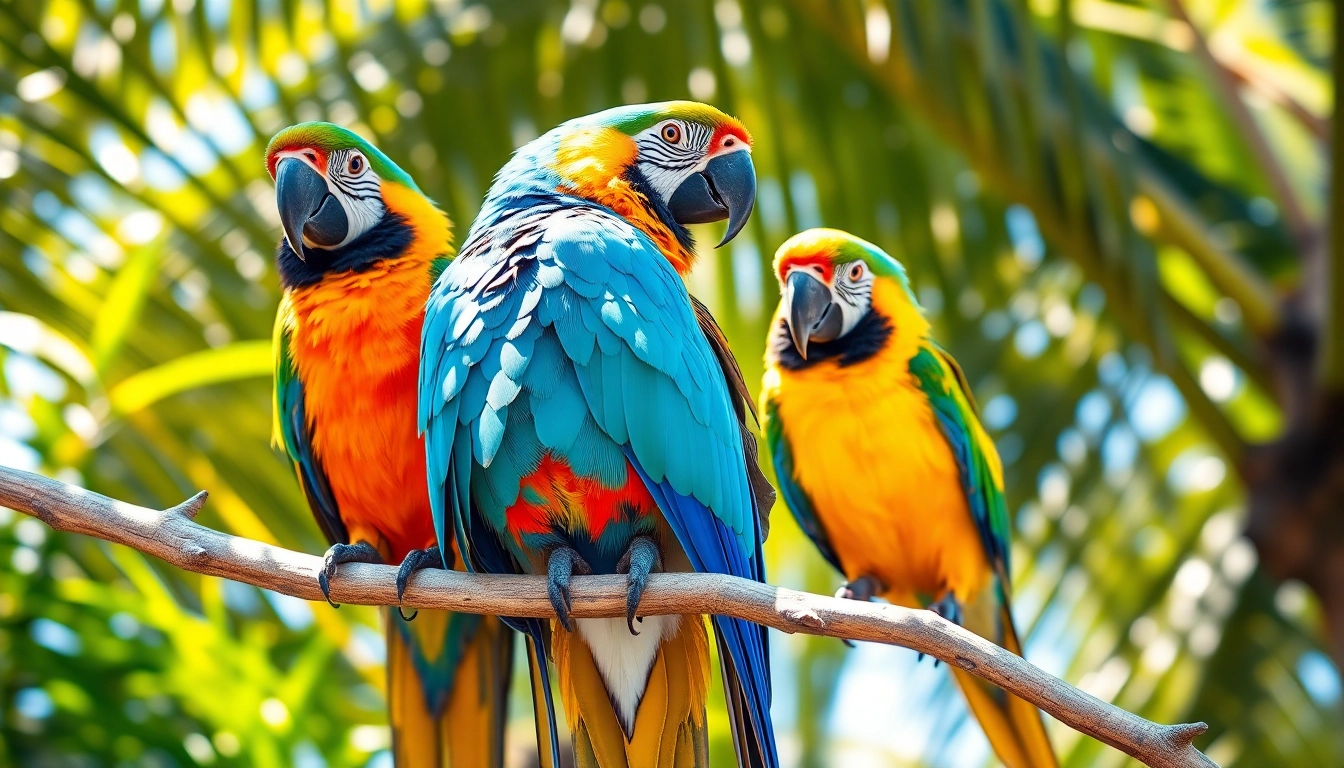Understanding Parrots: Characteristics and Types
Parrots, also known as psittacines, are among the most colorful and intelligent birds in the avian world. Their vibrant plumage, remarkable cognitive abilities, and social behaviors have captivated bird enthusiasts, conservationists, and pet owners alike. Recognizing the diversity and unique traits of parrots is essential for appreciating their ecological significance, ensuring proper care, and supporting conservation efforts. This comprehensive guide delves into the physical attributes, popular species, behavioral nuances, and conservation challenges faced by these fascinating birds.
Physical Attributes of Parrots
Parrots are characterized by their distinctive morphology, which includes a strong, curved beak, upright stance, and clawed feet. These features are adaptations that enable them to forage effectively, manipulate objects, and perform complex behaviors. Their size, coloration, and lifespan vary significantly across species, reflecting their diverse habitats and evolutionary paths.
Distinctive Anatomy
One of the most recognizable features of parrots is their beak, which is not only powerful but highly specialized for cracking nuts, seeds, and other tough food items. The upper mandible is typically curved and can be moved independently, giving parrots exceptional manipulation abilities. Their clawed feet, often zygodactyl (two toes facing forward and two backward), provide strong grip and dexterity, facilitating climbing and handling of food.
Coloration and Size
Parrot plumage is renowned for its vibrant, eye-catching colors—ranging from deep greens and blues to fiery reds and yellows. This dazzling coloration plays roles in camouflage within lush environments, mate attraction, and social signaling. Sizes range from small lovebirds (as little as 5 inches) to large macaws and cockatoos spanning over 3 feet in wingspan, weighing up to nearly 8.8 pounds.
Lifespan Variability
Longevity is another aspect that distinguishes parrots. While smaller species like lovebirds may live around 10–15 years in captivity, larger parrots such as cockatoos and hyacinth macaws can live between 40 to 60 years or more in optimal conditions. Understanding their lifespan is vital for prospective owners and conservation planning.
Popular Parrot Species and Their Features
There are approximately 410 species of parrots classified into four primary families: Psittacidae, Cacatuidae, Strigopidae, and Psittaculidae. Some species have gained fame as pets, while others are celebrated for their wild beauty and ecological importance. Here, we explore key species and what makes each uniquely special.
True Parrots (Family: Psittacidae)
This is a diverse group that includes many well-known species, such as the African grey parrot, Amazon parrots, and Eclectus parrots. African grey parrots are celebrated for their exceptional talking ability and intelligence, often mimicking human speech with remarkable accuracy. Amazon parrots are hardy and sociable, known for their vibrant colors and loud calls.
Cockatoos (Family: Cacatuidae)
Cockatoos are distinguished by their prominent crests and predominantly white or pale plumage. Species such as the Sulphur-crested cockatoo are highly social and intelligent. They require significant mental stimulation to prevent destructive behaviors, making them both appealing and challenging as pets.
Macaws (Family: Psittacidae)
Hyacinth macaws and scarlet macaws are among the largest and most spectacular parrots. Their vivid coloration and impressive size make them icons of tropical forests. They are highly social, requiring large habitats and stimulating environments to thrive.
Other Noteworthy Species
- Lovebirds: Small, affectionate parrots popular as pets, known for forming strong bonds with their owners.
- Kākāpō: A critically endangered, flightless parrot endemic to New Zealand, renowned for its unique ecology and conservation efforts.
- Amazon Parrots: Highly vocal and intelligent, often used in research and conservation programs.
Differences Between Wild and Pet Parrots
Understanding the distinctions between wild and captive parrots is essential for fostering responsible ownership and effective conservation strategies.
Behavioral Variations
Wild parrots display behaviors adapted to natural environments—such as flock dynamics, foraging, and seasonal breeding—while captive parrots often develop bonding behaviors with owners, display certain stereotypies if unstimulated, and may have altered social interactions.
Physical Health and Longevity
Wild parrots face threats from habitat loss, predators, and disease, often resulting in shorter lifespans compared to their well-cared-for captive counterparts. Conversely, captive parrots can reach their maximum lifespan with proper diet, enrichment, and veterinary care, although they may be more prone to obesity or stress-related issues if neglected.
Diet and Environment
In the wild, parrots consume a diverse diet—fruits, seeds, nuts, flowers, and sometimes insects—adapted to their native ecosystems. Captive parrots require carefully balanced diets to match their nutritional needs, supplemented with fresh produce, formulated pelleted feeds, and occasional treats. Providing an environment that mimics their natural habitat reduces stress and improves overall well-being.
Habitat and Distribution of Parrots
Parrots predominantly inhabit tropical and subtropical regions, exhibiting a broad geographical distribution that highlights their ecological adaptability and evolutionary diversity.
Natural Environments for Parrots
Most parrots thrive in forests, woodlands, savannas, and coastal mangroves. Their habitats provide ample food resources and nesting sites, often in tree cavities or cliffs. The dense foliage offers protection and camouflage, essential for avoiding predators and thriving within their ecological niches.
Regions Where Parrots Are Found
Parrot distribution spans continents, with the highest diversity in Central and South America, Australasia, and parts of Africa and Asia. Notable regions include the Amazon rainforest, Australian bushlands, Madagascar’s forests, and Southeast Asian islands.
Parrot Populations Outside Their Native Ranges
Over recent decades, some species have established feral populations outside their historic ranges. For example, monk parakeets have thriving populations in urban areas of the United States and Europe, originating from escaped or released pets. These populations can have ecological impacts and are, in some cases, subjects of management efforts.
Parrot Behavior and Social Skills
Parrots are renowned for their complex social behaviors, communication skills, and capacity for play. Their behaviors serve crucial roles in bonding, survival, and environmental adaptation.
Communication and Vocal Abilities
Many parrot species possess an extraordinary capacity for vocal mimicry, often imitating sounds, human speech, and environmental noises. Studies highlight that African grey parrots, in particular, demonstrate advanced understanding of words and their contextual meanings, showcasing high cognitive abilities.
Vocalizations, gestures, and body language form a rich communication repertoire among parrots, facilitating social bonding and territoriality. Recognizing these cues is vital for owners to understand and cater to their pets’ needs.
Bonding and Affection Signals
Parrots form strong pair bonds and social groups, displaying attachment through preening, vocal calls, and seeking physical closeness. They may also demonstrate mutual grooming and share food as signals of trust and affection. For owners, mimicking or responding to these behaviors strengthens the bond and ensures emotional well-being.
Play and Enrichment Activities
Play is essential for their mental stimulation and physical health. Enrichment can include puzzle toys, foraging opportunities, mirrors, and safe perches. Engaging parrots in interactive activities reduces boredom, prevents destructive behaviors, and encourages cognitive development.
Care and Maintenance of Parrots
Providing high-quality care is fundamental to the health and longevity of parrots. Proper diet, environment, and medical attention foster a thriving avian companion.
Diet and Nutrition Tips
Parrots require a balanced diet rich in essential vitamins, minerals, and nutrients. Their diet should comprise high-quality formulated pellets, fresh fruits and vegetables, seeds (in moderation), and occasional treats like nuts. Avoiding toxic foods such as chocolate, caffeine, and avocado is critical.
Understanding their dietary habits—such as parrots eating with their feet—is crucial for designing engaging feeding routines that promote foraging behaviors and mental stimulation.
Housing, Toys, and Environment Enrichment
Birdcages should be spacious, with bars spaced appropriately and equipped with perches, toys, and opportunities for climbing. Environmental enrichment involves rotating toys, providing foraging opportunities, and allowing supervised outdoor flights when possible.
Light exposure, air quality, and humidity control also play roles in maintaining health. Regular cleaning and safe housing materials minimize infection risks.
Health Concerns and Vet Care
Common health issues include respiratory infections, feather plucking, malnutrition, and parasitic infections. Routine veterinary check-ups, proper vaccination, and prompt attention to symptoms ensure long-term well-being. Recognizing signs such as changes in appetite, droppings, or behavior allows early intervention.
Conservation Challenges and How to Help
Parrots face numerous threats stemming from habitat destruction, illegal trade, and climate change. Addressing these challenges requires a multifaceted approach involving legislation, public awareness, and on-the-ground initiatives.
Threats to Parrot Populations
Deforestation, illegal trapping for the pet trade, and invasive species have decimated wild populations. Many species are now critically endangered, with some like the Kākāpō being close to extinction. Climate change further threatens habitat integrity and food availability.
Global Conservation Efforts
Organizations such as the World Parrot Trust and BirdLife International implement habitat protection, breeding programs, and educational campaigns. International cooperation via CITES regulations seeks to curb illegal trade and ensure sustainable harvesting.
Habitat restoration projects and protected reserves serve as sanctuaries for vulnerable species, promoting recovery and genetic diversity.
How Enthusiasts Can Support Parrot Welfare
Individuals can contribute by supporting conservation organizations, avoiding the purchase of wild-caught parrots, and adopting responsibly bred pets. Educating others about the ecological importance of parrots and the threats they face amplifies impact. Responsible ownership, including providing proper care and advocating for habitat preservation, is equally vital.



